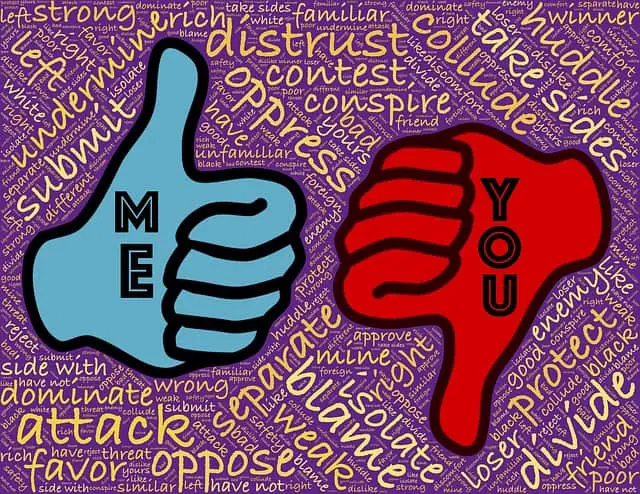What do we mean when we say psychopaths hide in plain sight? Most people think that most psychopaths are locked away safely in prison, or that the only psychopaths are the ones in the movies like Hannibal Lecter. Is this assumption true?
The reality is that most psychopaths walk free among us in society and are indeed hidden in plain sight, many of them holding down respectable jobs and appearing to live high functioning, successful lives.
Many are able to expertly craft a persona of being a normal person, even appearing as charming and likeable to people they meet in daily life. In this sense they are very clever at hiding.
Psychopaths are also very clever at concealing their tactics of emotional abuse and psychological targeting of others, often being able to hide their behavior in plain sight and flip situations around so others are blamed while they walk away without any consequences. The apathetic and easily influenced nature of so much of the general population is what allows them to get away with this.
In this sense, psychopaths are indeed masters of disguise and are very good at hiding, able to convince even the most experienced observer with their glib charm and superficiality. Thankfully they will always give themselves away over time though, by displaying a series of predictable toxic and manipulative character traits which can be spotted if the person looks past the surface charm they constantly put up to throw others off the scent. Let’s look at the issue in more detail.
Psychopaths Can Appear Perfectly Normal
The most obvious context in which psychopaths hide in plain sight is in the ability many of them have to blend into society undetected. A good number of psychopaths can appear to function normally, walking and talking like everyone else and holding down jobs.
Some even do very well for themselves in the workplace, using their ruthless psychopathic traits to move up the ladder in corporate environments especially. See our articles on psychopaths in the workplace for more on this.
This relates to the facade of normalcy or the “mask of sanity” that so many psychopaths learn to construct, giving off the air and appearance of being just like everyone else, when in fact they are anything but. Many learn to give off a glib air of superficial charm and charisma to take others in and throw them off the scent of who they really are. Unfortunately this tends to work on most people.
It is only later on when people get drawn into longer term relationships with these people that their more toxic, manipulative characters start to become apparent. People eventually start to see that they are emotionally abusive people who thrive on division and conflict, often singling out a particular person to undermine and isolate them whilst being seemingly fine with everyone else.
Sometimes they get found out this way and sometimes they don’t. It depends on the quality of the onlookers or bystanders in these kind of situations. If the target is lucky, then onlookers will eventually see the psychopath for who they are and realize they have been “played” by them, in which case the psychopath becomes marginalized and often has to move on to easier targets elsewhere.
Most often this unfortunately doesn’t happen though, and people’s personal lives and careers are often destroyed by these predators, who isolate them from support systems personally or push them out of jobs professionally by turning opinion against them. Psychopaths are masters of inverting reality and painting out good people to be the problem, while they themselves wall off scot free.
This dynamic is captured brilliantly in the book The Empathy Trap, which goes into detail about the so called sociopath-empath-apath triad. An empathic person will call a psychopath out on their unacceptable behavior but often “apaths” or weak bystanders will not support them or even side with the sociopath to make their life easier.
The empath is then left furious that the situation has somehow been turned on it’s head, with them the one now isolated and undermined despite correctly calling out the sociopath on something they had said or done. This situation is common and it is a trick the psychopath/sociopath plays out time and time again.
Psychopaths Love Playing Mind Games
Another way in which psychopaths like hiding in plain sight is in the mind games they love to play with others as their toxic relationship with whoever they are targeting deepens. They start to chip away at their victims psychologically, engaging in gas-lighting and other emotional abuse tactics to erode a person’s sense of reality and perception.
A crucial component to this though is that they love to make this obvious to the victim themself but keep it cleverly concealed from any onlookers or bystanders. This is part of the malevolence and wilfull destructiveness of psychopaths as they know full well what they are doing and are doing it on purpose.
They get a kick out of the fact that it’s just a mind game between the two of you, but that it’s being played out right in front of others without them realizing. This kind of thrill seeking is a compensation for the fact they feel so dead and empty inside. Here are a couple of ways they can do this:
- They will take cleverly concealed digs at the victim in work or personal scenarios in front of others, making statements which ostensibly mean one thing to the other people but also carry a different meaning to the victim. They bury a dig inside a statement or comment which is seemingly harmless to anyone else present.
- They will “triangulate” and isolate the victim by being seemingly nice and cordial with everyone else, laughing and joking, while being indifferent and cool with the victim only. This is a common tactic in work scenarios which serves to isolate and undermine the victim. Often the psychopath does not even like the onlookers they are co-opting into this and the cordiality is totally faked merely to play mind games with the victim.
- In more general terms psychopaths will take outrageous risks in relationships, doing grossly unacceptable things right under their partner’s nose which they know would elicit disapproval if they are caught, but they don’t care. The brazenness and the “in plain sight” nature of doing things they could easily get caught doing is what gives them the kick.
There are a couple of reasons they do this. Firstly, it helps to keep their toxic behavior concealed from any onlookers who may object. Sometimes this isn’t even the case though and they can start doing more and more outrageous things without any consequences if the apaths or onlookers are particularly low quality or easily influenced people. It depends on the situation.
Secondly, they get an internal kick out of playing these kind of mind games, as we mentioned above. It often helps them relieve the relentless internal boredom and emptiness so many of them experience by “riding the edge” and playing these games in plain sight without being detected.
Thirdly, it is simply part of the malevolence and evil of psychopathic and sociopathic characters that is basically incomprehensible to normal people with feelings, empathy and conscience. Anyone with these human qualities cannot relate to this behavior but psychopaths actually make it their mission in life to cause damage in the lives of others.
This stems from their own internal chaos and unhappiness and makes us realize that whatever power they hold over others and however well they do for themselves in society, we would not want to trade places with them.
They are chronically envious and destructive people who ultimately need to be pitied, though it is difficult to get to this stage for anyone who has been a victim of them in daily life.

Psychopaths thrive on negativity and division and are constantly setting people against each other to divert attention away from themselves.
The Role of The Crowd
It would be good if we could say this dynamic of psychopaths hiding in plain sight is entirely the fault of the psychopath but unfortunately it isn’t. Too often the majority of people are far too easily taken in by these characters, even when their toxic behavior starts to become more apparent down the line.
These people represent the apaths in the sociopath-empath-apath dynamic we mentioned. The empath or high quality, moral person will often call the psychopath/sociopath out of their unacceptable behavior but receive no support from these apathetic onlookers, who even sometimes side with the psychopath.
Empathic and observant people will sooner or later spot the fact that the psychopath’s surface act is just that – an act – and will try to get others to see that as well. Most often they are met with a shrugged shoulders kind of apathy from most people – an explicit or implicit “So?”. This apathy is exactly what psychopaths and sociopaths exploit and allows them to get away with everything they do.
Part of this is driven by moral weakness and apathy on the part of so many people, who would rather “go along to get along” and not rock the boat too much, especially in work environments.
Another major part of this is that so many people still cling to the stereotype that the only psychopaths that exist are the violent ones locked up in prison or on TV. These psychopaths are in fact only a very small portion of the whole and most of them remain at large in society, causing trouble in more covert, psychological ways.
Once society begins to move past this Hannibal Lecter style cliche and realize that by no means are all psychopaths violent, then hopefully more people will be able to open their eyes to the ones hidden in plain sight in daily life, wreaking havoc and chaos in the work and personal lives of others.
Psychopaths are estimated to represent only around 1% of the general population, yet are responsible for a massive proportion of the physical and psychological damage caused to the rest of society. The broader definition of sociopathy covers around 4% of the population and includes people who display essentially similar destructive traits.
The growing body of resources on this in the form of books and videos is helping to spread the word on this wider definition of psychopathy, helping people to spot the common traits which give psychopaths away if one is looking close enough, as well as the predictable patterns of emotional abuse such as gas-lighting that they engage in.
Some of the more common traits to look out for are:
- Glib, superficial charm
- Egotistical, self centred personality.
- Constant tendency towards dishonesty.
- A hidden past they have not revealed to you
- Charming at first but emotionally abusive once a relationship is established, employing tactics such as “gas-lighting” to chip away at a person’s identity and perception
- Fundamentally a manipulative and deceitful character, constant backstabbing and sniping. Thrive on negativity and division.
- Relentless projection of blame and inversion of reality – nothing is ever their fault.
- No vocational or charitable aspects to their character – solely focused on power, ego and dominance over others.
- See our PCL-R page here for more detail on all traits.
See our Resources Page for some of the best books and videos on identifying and dealing with psychopaths.
